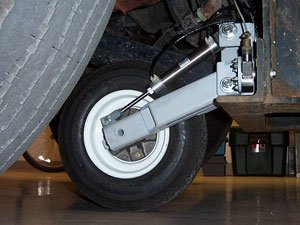Smarter snowplows

U researchers enhance automated sanding and salting system for plows
The sensor system that measures friction is attached to a wheel near the front axle of the plow. U researchers Rajesh Rajamani, Lee Alexander, and Gurkan Erdogan are developing the system for the Minnesota Department of Transportation.
By Rick Moore
'Tis the season to not be so jolly ... if you're driving around in the snow. As evidenced again last week, even a little bit of snow in rush hour goes a long way toward a bumper-to-bumper mess on Twin Cities roads. Imagine what Grinches we'd all be without Minnesota's well-oiled (generally) system of snow removal and sanding.
Take heart-things may be getting better soon. Researchers at the University of Minnesota are working on a method to make that latter process-the sanding and salting of roads-more efficient and cost-effective, which could benefit all Minnesotans.
The U is enhancing technology that helps snowplows determine exactly where slippery patches are and to target those specific areas with their sand-and-salt mixtures.
It's all based on measuring friction coefficients, and for those of us whose brains feel frostbitten when discussing coefficients, here's what happens. A sensor system is attached to a wheel near the front axle of the snowplow, and when the sensor filters out the vibration "noise" and detects a loss of friction, it sends a signal to the sand-spreading equipment. A mere fourth of a second later-about the time it takes the applicator to arrive at the ice-the sand begins to fly.
"We are hoping that this technology will be evaluated by MnDOT supervisors and snowplow drivers on two or three snowplows during the next year," says Rajamani.
This automated system yields several benefits, according to researcher Rajesh Rajamani, a professor in the U's Department of Mechanical Engineering who helped develop the technology along with colleagues Lee Alexander and Gurkan Erdogan. For one, it will be helpful to know portions of road that tend to get slippery, and by using GPS technology, the Minnesota Department of Transportation (MnDOT) could create a database of problematic areas.
The technology will also make things easier for plow drivers, who face enough challenges as it is.
"The snowplow driver has to use the blade, clear the snow on the road, and drive in very bad conditions," Rajamani says. "Just driving and plowing the snow is a lot of work. By not having the driver also control the applicator and decide when to sand and when not to sand and what the rate of sanding should be, you're reducing the burden on the driver."
Staying below sea level
This smarter snowplow also stands to save a lot of sand and salt. Estimates suggest that Minnesota uses more than 200 pounds of sand and salt per person each winter, says Alexander, a research fellow who has worked with Rajamani on the technology for about five years. "It's just as important to know when to turn the sand off," Alexander says.
Which is sometimes easier said than done. "Snowplow drivers don't like to have accidents on their routes, so if anything they tend to try a little too hard to make sure [there's enough sand and salt]," he says. "If we can assure them that [in certain locations] everything is fine, they can use less salt and still keep the roads clear." (Rajamani points to an article saying that salt levels in area lakes can approach 50 percent that of oceans at peak times in the winter.)
Even if the final embodiment of the relatively inexpensive sensor equipment is slightly different from what's being tested, the researchers are confident it can be street- and highway-ready soon.
"We are hoping that this technology will be evaluated by MnDOT supervisors and snowplow drivers on two or three snowplows during the next year," says Rajamani.
Watch a short video of a friction sensor-equipped snowplow in action.
